Choosing the Best Soil for Successful Seed Germination
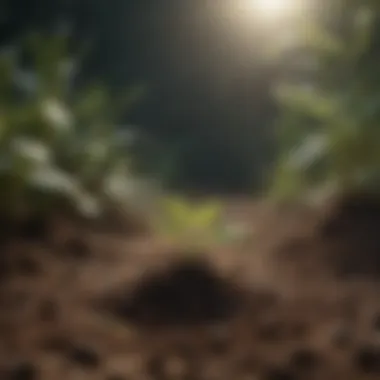
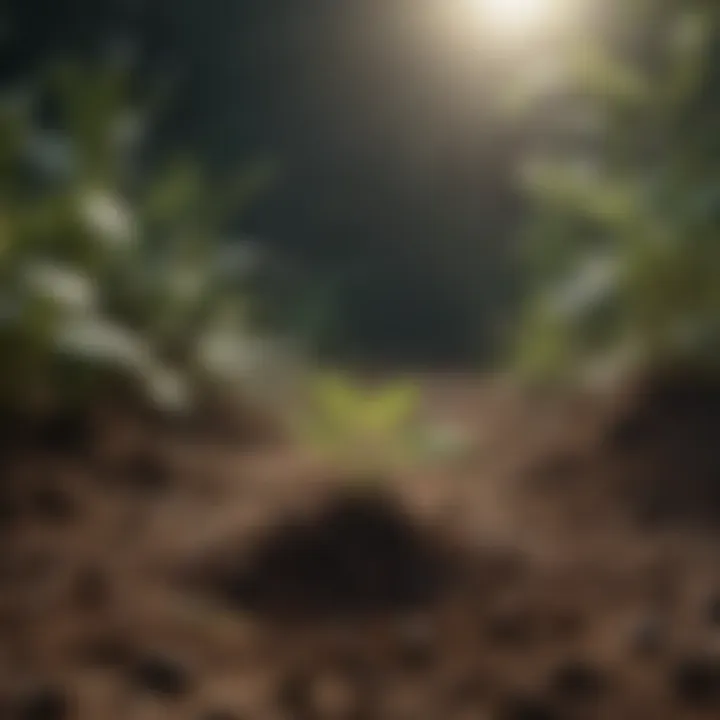
Intro
Choosing the right soil for seed germination goes beyond simply grabbing a bag from the store. When planting seeds, it's like laying down the foundation for a house. If you start with weak or unsuitable soil, you're setting yourself up for a bumpy ride. Healthy plants need more than just sunlight and water; they require specific soil characteristics to thrive. This article will take a closer look at soil types, their unique traits, and how they impact seed germination.
The journey into effective seed starting isn’t just about nutrients; it’s about understanding the delicate balance of pH levels, drainage, and organic matter. Let's delve deeper into these factors and uncover how to make informed choices for your garden. This guide serves those who cherish gardening, whether you're a home gardener with a green thumb or someone just trying your hand at growing plants indoors.
Understanding Soil Types
Different soils have distinct properties that influence germination. Here’s a quick breakdown:
- Clay Soil: While it holds nutrients well, clay compact readily and can create drainage issues.
- Sandy Soil: It drains quickly and warms up fast, which is great for some seeds but requires frequent watering.
- Loamy Soil: This is often viewed as the gold standard for gardening. It's a blend of sand, silt, and clay, providing a balance of drainage and nutrient retention.
Each soil type will interact uniquely with the seeds you choose to plant, making it essential to select wisely based on your specific gardening goals.
Key Soil Characteristics
For optimal seed germination, consider the following:
- Nutrient Content: The soil must contain essential nutrients, like nitrogen, phosphorus, and potassium. These support healthy seedling growth.
- pH Levels: Soil pH can significantly affect nutrient availability. Most seeds thrive in slightly acidic to neutral pH levels, ideally around 6.0 to 7.0. You can test your soil easily with a home kit.
- Drainage: Good drainage prevents waterlogging that can drown seeds or cause root rot. Integrating organic matter enhances both drainage and nutrient content.
- Texture: The texture of your soil matters too, as it affects air circulation in the root zone.
“The best seed starts in soil that meets the seeds' specific needs like a tailored suit.”
The Role of Soil Amendments
Soil amendments can drastically improve your soil's ability to support seed germination. Think of them as nutritional supplements for your garden. Popular amendments include:
- Compost: Packed with nutrients and enhances soil structure. It encourages beneficial microorganisms.
- Peat Moss: Improves water retention and aeration but can be unsustainable if over-harvested.
- Vermiculite and Perlite: These materials enhance drainage and aeration, particularly in potting mixes.
Incorporating these amendments can lead to a thriving garden, providing your seeds with the boost they need during their crucial reproductive phase.
Finale
Selecting the ideal soil for seed germination is not just a straightforward task; it's an art and a science. Understanding soil types, their properties, and the importance of amendments ensures that your seed starting efforts yield healthy, robust plants. By paying attention to the details and making informed choices, your gardening endeavors will yield bountiful results.
Importance of Soil in Seed Germination
Soil is more than just dirt beneath our feet; it provides a crucial foundation for plant life. When it comes to seed germination, the type of soil a gardener chooses can significantly influence the outcomes of their efforts. This article delves into that importance, weaving together the intricate relationship between soil and seed success.
The Role of Soil in Plant Growth
The soil serves as a dynamic reservoir for essential elements and nutrients that seeds need to break through their shells and begin growing. It's not just a static medium either; the composition and structure of the soil can shift, affecting water retention, aeration, and the availability of nutrients.
A well-structured soil has various layers and components that work together in harmony. For example, sandy soil might allow water to drain too quickly, depriving seeds of the moisture they require, while clay-heavy soils could hold too much water, leading to drowning seeds. In this dance of elements, the right balance is key, as it promotes healthy root development and the overall vigor of the plant.
"Healthy soil is the cornerstone of robust plant growth. Without it, a garden is just a dream waiting to wither."
Impact of Soil Quality on Seedling Development
Quality of the soil can make or break how well a seedling develops. Nutrients such as nitrogen, phosphorus, and potassium, along with trace minerals, play vital roles in leaf growth, root development, and flower production. Whereas some gardeners might think fertilization alone can solve nutrient deficiencies, they overlook that the initial soil quality is paramount in the germination phase.
- Healthy soil is usually rich in organic matter which aids in nutrient absorption.
- Poor soil can lead to nutrient lockout, where even if fertilizers are applied, seedlings may still fail to thrive.
When selecting soil, it isn't just about what ingredients are mixed in; understanding soil texture, drainage levels, and pH balance can also impact how effectively seedlings access these nutrients. Over time, gardeners learn that investing in quality soil at the outset pays off exponentially, producing plants that flourish rather than wither.
In summary, the importance of soil in seed germination cannot be overstated; it's the vital ingredient that supports a seed's journey from dormancy to thriving plant. A solid grasp of soil's role not only enhances germination rates but also lays the groundwork for a flourishing garden.
Types of Soil for Starting Seeds
Understanding the types of soil suitable for starting seeds is vital for achieving a successful germination rate. The correct soil provides the necessary balance of moisture retention and drainage, influencing the seed’s ability to sprout and establish roots. Each type of soil serves distinct purposes, offering unique benefits that cater to the various needs of different seeds. Choosing an appropriate soil means looking beyond just what’s available at the store; it requires consideration of the seed variety, growth conditions, and local climate.
As you delve into the heart of seed starting, think about whether your aspirations lie in cultivating vegetables, flowers, or perhaps herbs. This can make all the difference in your choice of soil, optimizing the potential for a bountiful garden.
Seed-Starting Mixes
Seed-starting mixes are specially formulated soils designed to maximize the chances of germination. Comprised mostly of peat moss, vermiculite, and perlite, these blends are lightweight and provide excellent aeration and drainage. This is a primary consideration since seeds need air pockets around them to flourish.
Unlike general-purpose garden soils, seed-starting mixes typically lack heavy nutrients. This might seem counterintuitive at first, but an excess of nutrients can, paradoxically, impede young seedlings as they become overwhelmed, which can hinder their development. Instead, the focus is on providing a sterile environment to reduce risks associated with pests and diseases.
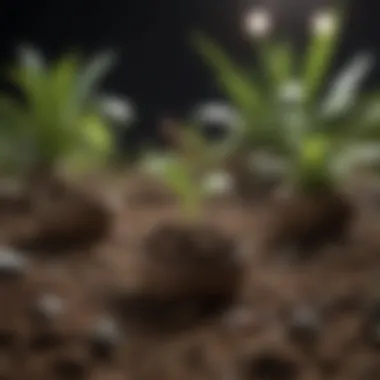
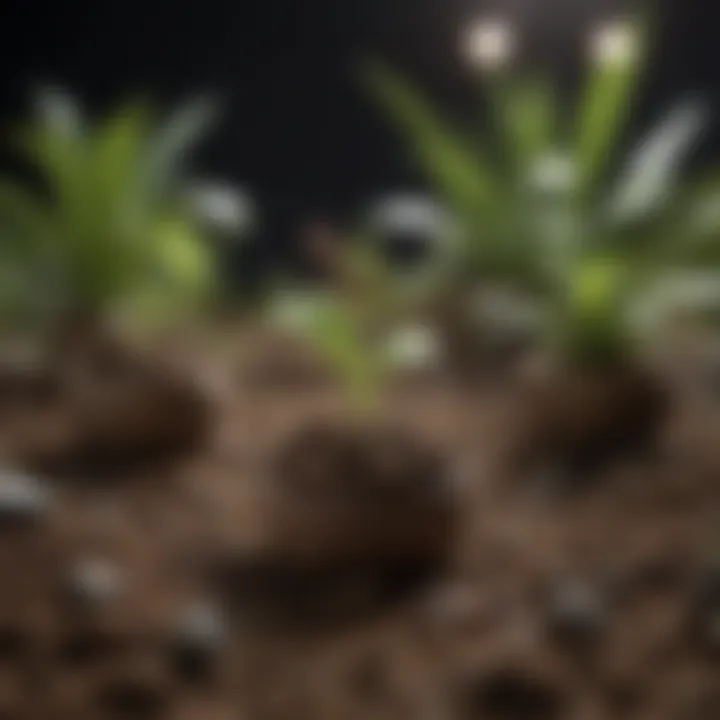
"Choosing the right seed mix is a bit like choosing the right outfit for an occasion; it sets the tone for growth."
Here are some advantages of seed-starting mixes:
- Lightweight Composition: This helps new seeds to break through more easily.
- Balanced Moisture Retention: They hold just enough moisture without becoming soggy.
- Reduced Disease Risk: Less likely to introduce pathogens that can harm young plants.
Garden Soil vs. Potting Soil
With gardening, distinguishing between garden soil and potting soil can be the crux of your success. Garden soil is harvested from the outdoors — think of the black gold beneath your feet. It tends to be heavier, enriched with organic matter from local flora and fauna. However, this type of soil isn’t always appropriate for starting seeds; its density can lead to drainage issues, suffocating young roots.
Potting soil, on the other hand, is engineered for container gardening. Generally, it’s lighter and is made up of a mix of peat moss, vermiculite, and compost. This ensures that it stays airy and promotes drainage, much like a seed-starting mix but with added nutrients. Using potting soil for seeds can give a psychological edge, as seedlings receive a rich start without overwhelming them with too much nutrition.
Key Comparisons:
- Texture: Garden soil is typically coarse and heavy, while potting soil is finer and lighter.
- Nutrient Content: Garden soil can be variable; potting soil has consistent nutrient levels and is often enriched.
- Drainage: Potting soil is usually superior in drainage capabilities compared to garden soil.
Specialty Soils for Specific Plants
In some cases, certain plants require their own unique soil blends, tailored to their specific needs. Understanding these can provide a significant advantage. For vegies like tomatoes, a peat-based mix with nutrients is optimal. For orchids, a chunky mix that allows air movement is critical. Cacti and succulents favor gritty, fast-draining mixes to prevent root rot.
Here are a few examples of specialty soils:
- Cactus Mix: A sandy blend allowing fast drainage, perfect for succulents.
- Orchid Bark Mix: A chunky mix that keeps air circulation high and moisture around the roots.
- Hydroponic Solutions: For those venturing into soil-less gardening, hydroponic mixes can provide nutrients directly to the roots.
By aligning your seed choice with the proper specialized soil, you can pave the way for robust seedlings.
Characteristics of Ideal Seed-Starting Soil
Selecting the right soil for starting seeds is not just a matter of convenience; it can spell the difference between a thriving garden and one that barely gets off the ground. When it comes to the characteristics of ideal seed-starting soil, attention to detail is key. This not only affects germination rates but also the overall health of the seedlings. A well-rounded understanding of soil texture, nutrient content, and pH levels lays the groundwork for informed decisions in gardening.
Texture and Structure
The texture and structure of soil play crucial roles in seed germination. A balanced mix of soil particles—from sand, silt, and clay—creates a diverse environment for seeds to thrive. This balance is like a well-crafted recipe where too much of one ingredient can spoil the dish. For instance, sandy soils drain quickly, which can be great for seedlings that don’t like to stay wet but too much drainage may lead to insufficient moisture retention.
Ideally, a good seed-starting mix should have a light and airy texture. This can be achieved by incorporating materials like perlite or vermiculite. These not only improve airflow but also help retain some moisture. A chunky soil structure promotes root growth by allowing young seedlings to establish themselves without the hinderance of compacted mud. Aeration and drainage enhance the soil’s ability to handle watering without becoming waterlogged, which is detrimental to seedlings.
Nutrient Content
When it comes to nutrient content, this is another pillar upon which healthy seedlings stand firm. Young plants require a balanced intake of nutrients to kickstart their growth. This includes not only macronutrients like nitrogen, phosphorus, and potassium but also micronutrients like calcium and magnesium.
Using a high-quality seed starting mix can give seedlings a significant head start. Some mixes come enriched with peat moss, compost, or organic fertilizers, providing those essential nutrients right from the get-go. Adding organic matter such as compost can bolster nutrient density, giving roots the sustenance they need to establish themselves firmly in the soil. Just remember, over-fertilizing can lead to nutrient burn—a certain way to kill seedlings before they even get a chance to thrive.
pH Levels and Seed Germination
The pH level of the soil is another critical factor that can’t be overlooked. Soil pH affects the availability of nutrients to plants and can influence germination success. Most seeds prefer a slightly acidic to neutral pH, ideally between 6.0 and 7.0. At this level, nutrients are often more accessible to plants.
To check the pH levels, basic home testing kits are widely available and easy to use. If the pH is off-kilter, amendments like lime can be used to raise pH, while sulfur can help in lowering it. Adjusting your soil’s pH not only benefits seedlings but can also set the stage for long-term plant health and vigor.
Understanding these key soil characteristics is essential for anyone eager to see their seeds blossom into healthy plants.
The interplay of soil texture, nutrient content, and pH levels creates an environment conducive to seed germination. By focusing on these elements, gardeners set themselves up for success, ensuring their seeds have the best possible chance to thrive.
The Role of Soil Amendments
Soil amendments serve as vital tools in the gardener's arsenal, impacting seed germination and subsequent plant health significantly. The quality of soil often leaves much to be desired, especially in urban areas where the dirt can be more clay than nutrient-rich earth. Amendments are not merely an option; they become a necessity to create a thriving environment for your seeds. By fortifying soil with the right components, one can enhance its character, ensuring seedlings can establish robust root systems, rich in nutrients necessary for their development.
When considering a soil amendment, keep in mind several factors: what you want to achieve with your garden, the existing soil quality, and the specific plant types you intend to cultivate. The nuanced balance of these elements shapes the success of your seedlings. Like seasoning a meal, judicious tweaks can elevate your garden results exponentially.
"A well-amended soil is like a buffet for roots; they’ll feast and flourish."
Common Soil Amendments
Among the myriad soil amendments available, a few stand out due to their efficacy and popularity:
- Compost: Arguably the champion of soil amendments, compost enriches the soil with nutrients while improving its texture. It partners well with plants, fostering a symbiotic relationship that encourages growth.
- Peat Moss: A staple in many gardeners' mixes, peat moss helps improve moisture retention. Its lightweight nature ensures that seeds won't drown in soggy settings.
- Vermiculite and Perlite: These lightweight materials enhance aeration and drainage. They give the soil a good fluffiness, preventing it from becoming waterlogged and promoting healthy root growth.
- Lime: Often added to counteract acidity, lime is essential when soils pitfall into being overly acidic, affecting seed germination.
- Bone Meal: This is a great source of phosphorus, which plays a pivotal role in root development.
Benefits of Organic Matter
Adding organic matter to soil is akin to providing a multivitamin; the benefits are plentiful. Ingredients like compost or well-rotted manure enrich the soil, introducing a diverse spectrum of microorganisms that promote nutrient availability. This amalgamation boosts the soil structure, leading to improved aeration and moisture retention.
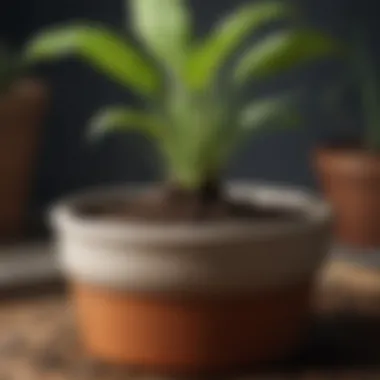
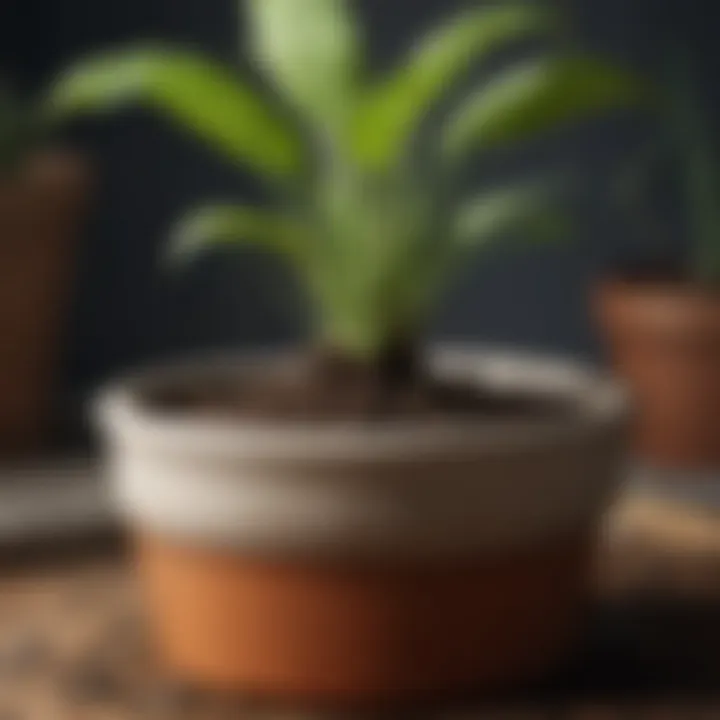
Organic matter also fosters enhanced nutrient cycling, which is paramount for healthy plant development. When decomposed, organic matter converts into humus, improving soil fertility. Don't overlook the environmental aspect; these amendments promote sustainability by recycling waste materials back into the ecosystem.
Enhancing Drainage and Aeration
It's not just about what you add; it’s equally about how it aligns with the soil's drainage and aeration. Poor drainage can lock seedlings in an environment hostile to growth, leading to rot or other complications. Employing amendments like perlite and vermiculite can help achieve a balanced moisture level.
By ensuring that soil has adequate drainage, you also facilitate aeration. Seeds require oxygen to germinate efficiently, and roots must breathe as they develop. In compacted soils, this essential gas may become trapped. Additions like coarse sand can break up the heaviness, enhancing both drainage and aeration, setting the stage for successful seed sprouting and robust plant growth.
The Importance of Drainage
When it comes to successful seed germination, drainage is a cornerstone component that gardeners often overlook. Poor drainage can create a soggy situation where seeds drown or fail to thrive, while proper drainage promotes a healthy environment for root development. The significance of drainage extends beyond water movement; it also influences aeration, nutrient availability, and overall soil health.
Understanding Soil Drainage
Soil drainage refers to how well water circulates through the soil. Ideally, soil should allow excess water to escape while retaining enough moisture for the seeds. This balance is critical when nurturing seeds—too much saturation can lead to root rot, while too little moisture may cause seeds to dry out and fail to germinate.
There are several factors to understand about drainage:
- Soil Texture: Sandy soils typically drain better than clay soils, which tend to hold onto moisture.
- Structure: Compact soil can inhibit water movement, creating a barrier that prevents adequate drainage.
- Organic Matter: The inclusion of organic materials can improve soil structure and drainage, promoting a healthier growing environment.
Signs of Poor Drainage
Recognizing the signs of poor drainage is crucial for any gardener aiming for optimal seed germination. Here are some indicators to watch for:
- Pooling Water: If you see water collecting on the surface after rain or watering, that’s usually a red flag.
- Soggy Soil: Consistently damp soil, especially several days after rainfall, indicates inadequate drainage.
- Moss or Algae Growth: Unwanted plant growth on the soil surface can suggest over-saturation and poor aeration.
- Wilting Plants: Paradoxically, plants that droop may not solely be suffering from drought. They might be waterlogged due to compacted soil, signaling poor drainage conditions.
Such signs call for immediate attention, as each delay can hinder seedling growth.
Improving Drainage Solutions
If you find your garden soil lacking in drainage, don’t fret; there are steps you can take to amend the situation. Here are some practical tips to enhance your soil’s drainage capabilities:
- Aerate the Soil: Use a garden fork or aeration tool to create holes, which can help water escape and improve air circulation.
- Add Organic Matter: Incorporate compost or well-rotted manure, which enhances soil structure and encourages beneficial microbial activity.
- Utilize Raised Beds: Building raised planter beds allows for better drainage, especially in heavy soils where pooling occurs.
- Install Drainage Pipes: In severe cases, creating a drainage system may be necessary to divert excess water away from planted areas.
In summary, understanding and addressing drainage is a fundamental aspect of preparing soil for seed germination. A well-draining soil promotes vigorous plants, making it the secret sauce for a thriving garden.
"Soil isn’t just dirt; it’s the lifeblood of your garden. If there’s a problem with the drainage, there’s a problem with growth."
By keeping an eye on these elements and implementing solutions, you’ll provide a conducive environment for your seeds to sprout and ultimately flourish.
Commercial vs. Homemade Soil Mixes
When it comes to selecting soil for seed germination, the choice between commercial mixes and homemade alternatives can significantly impact the success of your plants. Both options carry distinct characteristics and benefits, and understanding these nuances is essential for any enthusiastic gardener looking to optimize their seed-starting efforts.
Advantages of Commercial Mixes
One of the primary advantages of commercial soil mixes is consistency. These blends are often formulated by specialists who understand the specific needs of different plants. You might say they’re like a chef creating a signature dish—each ingredient is carefully measured to provide the best flavor, or in this case, growth potential.
Commercial mixes usually contain a balanced blend of peat moss, vermiculite, and/or perlite, delivering a lightweight and airy medium that promotes good drainage and aeration. This means more oxygen can reach those delicate roots, encouraging stronger seedling development.
Additionally, many commercial mixes are pre-fortified with fertilizers and essential nutrients, allowing seeds to receive a head start without the need for immediate amendments. This is particularly beneficial for beginner gardeners who may not yet have the knowledge or experience to create their own custom blends.
Creating Your Own Mix
For those with a more hands-on approach, crafting a homemade soil mix offers flexibility and a personalized touch. By tailoring your mixture, you can finely tune it to meet the specific demands of the seeds you’re starting. Many avid gardeners find joy in mixing components such as coconut coir, compost, and perlite or sand to create a blend that suits their needs.
Homemade mixes can be adjusted based on the plant type, climate, or even the stage of growth. For instance, if the seeds require more moisture retention, you might opt for a mix that has a higher proportion of coir or peat. This ability to customize means you can be as creative as a painter with their canvas, concocting a blend that gives your seeds every chance to thrive.
To create a basic seed-starting mix at home, consider the following:
- 1 part peat moss or coconut coir
- 1 part compost
- 1 part perlite or vermiculite
Mix these ingredients well to achieve a uniform texture that will adequately support root development.
Cost Considerations
Cost is a pivotal factor in deciding between commercial and homemade soil mixes. Depending on the quality and brand, commercial mixes can vary widely in price. Although many gardeners appreciate the convenience and performance of these products, consistently purchasing them can add up. If you’re working on a large gardening project, those expenses might start pinching your budget.
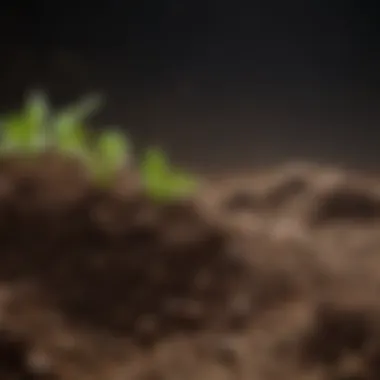
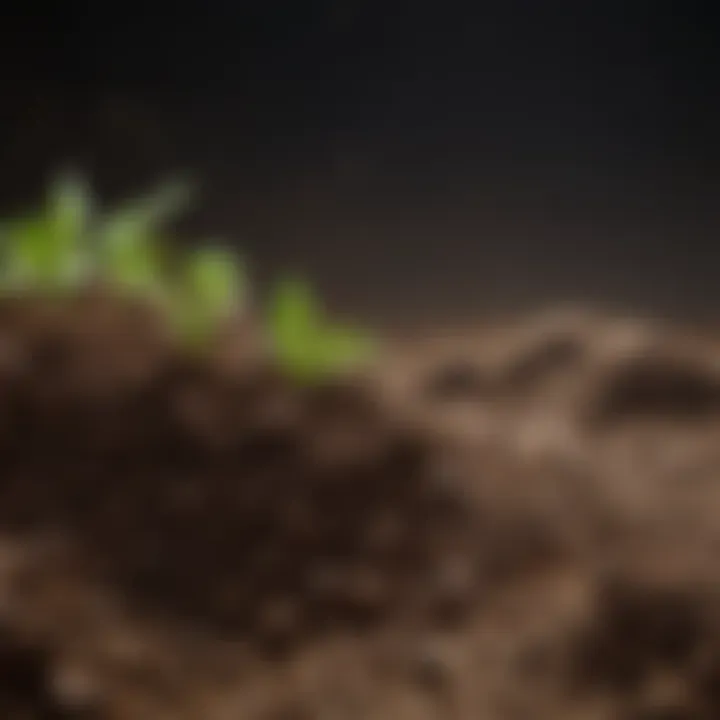
On the flip side, creating your own mix can often be more economical, especially if you have access to bulk materials. Local garden centers often sell components like compost or coir at reasonable prices. Furthermore, if you’re already composting at home, that’s a prime resource to utilize, reducing both waste and expenses.
Of course, it’s wise to weigh the initial investment against long-term results. Sometimes, spending a bit more on a quality commercial mix might yield better plants, which could lead to a healthier garden in the long run.
Understanding Seed Needs
When it comes to gardening, understanding seed needs is not just a luxury; it’s a necessity. Selecting the right soil for seed germination can make or break your gardening efforts. It is essential to realize that not all seeds have identical requirements when it comes to their growing medium. This section will shed light on the distinct needs of various seeds and why it's critical to cater to these differences.
Different Seeds, Different Requirements
Seeds can be as individualistic as people. Each type of seed has its own optimal conditions that promote successful germination. For instance, vegetable seeds often have unique moisture, light, and temperature preferences.
- Beans prefer a well-drained, loamy soil that stays slightly moist yet never waterlogged. If the soil is too dense or holds too much water, you might end up with mushy seeds.
- Tomatoes thrive in slightly acidic soil, ideally with a pH between 6.0 and 6.8, which helps in nutrient absorption. The right pH can be the difference between producing a bumper crop or a meager yield.
- Cucumbers, on the other hand, are heavy feeders that flourish in rich, organic matter-heavy soil, making compost an essential addition to their growing environment.
Understanding these nuances ensures that seeds can tap into the nutrients they need from the get-go. Reading seed packets can provide invaluable insights into specific needs, so take a moment to glance at those instructions.
Timing and Temperature Considerations
The timing of your seed planting is just as crucial as the soil you choose. Different seeds germinate at different rates and respond distinctively to temperature fluctuations. Some commonly sown seeds, like lettuces and peas, can handle cooler soils, while others, such as peppers and eggplants, may need a bit of warmth to kickstart their growth.
- Cool-season crops (e.g., spinach, brassicas) prefer soil temperatures between 50°F and 65°F for optimal germination. If planted too early, they might rot in colder, damp conditions.
- Warm-season crops (e.g., squash, corn) typically need soil temperatures of at least 65°F to germinate effectively. Don’t rush into sowing these seeds; waiting for the right warmth can save both time and frustration.
In essence, you must marry your seed type with the right soil and place it in a favorable environment for success. Plants are not just stubborn; they are particular.
"A seed’s journey begins the moment it encounters a soil that meets its unique needs. Understand that journey for thriving plants."
In a nutshell, managing these variables plays a pivotal role in navigating the complex world of seed germination. By tailoring your approach to the specific requirements of each strain, you can craft an environment that not only aids in their development but also boosts the health of your garden as a whole.
Troubleshooting Seed Starting Issues
Troubleshooting seed starting issues can be the difference between a garden bursting with life and a disappointing patch of failures. It’s easy to get caught up in the excitement of planting seeds, but not all seeds sprout as expected. By addressing problems early, you can enhance your chances of successful germination. Understanding what goes wrong allows you to make informed decisions about how to correct the course.
This section dives deeper into common issues that arise during seed starting and the best methods to address them. There’s an assembly line of factors affecting seeds—temperature, moisture, soil quality, and more. Every detail matters, and recognizing which hiccup in the process needs correction is essential for achieving robust plants.
Common Problems and Solutions
Many gardeners face similar problems when starting seeds. Here are a few common challenges and their solutions:
- Damping Off: This soil-borne disease dampens your seedlings’ chances by creating a slimy, unhealthy layer around the base, causing them to wilt and fall over. Solution: Ensure good air circulation and avoid over-watering. A mix of sand or perlite in your seed-starting mix can improve drainage.
- Poor Germination Rates: Seeds not sprouting? Solution: Check for seed freshness. Old seeds lose their viability. Also, ensure you’re using the right temperature. Most seeds require warmth to germinate, often needing a range of 65-75°F.
- Leggy Seedlings: These are tall, spindly plants that haven't developed properly, which usually occurs due to a lack of light.
Solution: Place lights closer to seedlings or provide additional light sources to encourage strong, healthy growth. - Soil Crust Formation: This can create a barrier that prevents water from reaching your seeds.
Solution: To prevent this, lightly sprinkle mulch over the top of your soil. Also, avoid watering in a strong manner to minimize crusting effects.
When to Revise Your Soil Choice
Sometimes, the soil choice itself is the root of your germination woes. Review your current soil and see if it meets the needs of your seeds:
- Nutrient Profile: If seedlings are yellowing, it might be time to look at the nutrient content of your soil. Lack of essential nutrients like nitrogen can stunt growth.
- pH Levels: Most seeds prefer a slightly acidic to neutral pH—around 6.0 to 7.0. Testing your soil may reveal imbalances that need addressing. You can adjust pH with amendments like lime for alkaline conditions or sulfur for intense acidity.
- Texture and Moisture Retention: If your soil is too compacted or clay-like, it can suffocate roots. On the flip side, very sandy soils may hold too little moisture. Mixing in organic matter can often help improve both issues.
Each misunderstanding of soil can lead to seedlings struggling to establish themselves. As they say, changing your strategy mid-game can still lead to a win. Keeping an eye on these factors and revising your soil composition as needed ensures your seeds have the best shot at germination.
Remember that troubleshooting isn't just about fixing problems; it's about learning what plants really thrive on—so you can replicate success in future planting seasons.
Final Considerations for Seed Success
Selecting the right soil for seed germination is just the beginning of a journey that culminates in flourishing plants. However, it's vital to anchor your endeavors with ongoing evaluation and adjustments. This is not a ‘set it and forget it’ kind of deal; keeping an eye on your soil during the germination phase can significantly determine success. Key considerations include assessing your soil mixture, monitoring how well seeds sprout, and being prepared to pivot your strategy based on what you observe. This final segment emphasizes why these checks are essential, and offers guidance on how to effectively carry them out.
Evaluating Your Soil Blend
Once you've chosen a soil blend, it's essential to periodically reevaluate its performance. Indicators like seed sprouting rates and seedling health can signal whether your mix is hitting the mark. Does your blend retain moisture well, or does it dry out too quickly? Noticing these little things can pay off big.
Here are some specific points to keep in mind:
- Moisture Retention: Check if the mix keeps moisture adequately without becoming soggy. Seeds that sit in overly wet soil can suffer from rot. If you’re noticing quicker evaporation, consider incorporating materials like coconut coir or sphagnum moss.
- Nutritional Content: You might want to run a soil test to find out the nutrient composition. Are seedlings looking pale and spindly, or are they green and standing tall? Adjusting your mix to include fertilizers can result in stronger growth.
- pH Balance: The ideal pH for most seedlings is around 6.0 to 7.5. If your pH strays far from this, it can hinder nutrient availability. Using a pH meter or test strips can be helpful to maintain balance.
Monitoring Germination Progress
Monitoring how your seeds are germinating is crucial. It’s not simply a matter of expecting them to take off on their own. Keep an eye on:
- Timeframe for Germination: Different seeds germinate at different rates. Familiarize yourself with the typical timeline for your specific seeds. If something doesn’t seem quite right—like seeds failing to sprout within their expected period—this could be a sign that something is amiss with the soil or conditions.
- Seedling Development: Evaluate the health of emerging seedlings. If you consistently notice weak or discolored seedlings, don’t just shrug it off. Dig deeper to assess the soil blend and conditions.
"Monitoring is about being proactive rather than reactive. You catch problems before they become full-blown issues."
- Environmental Factors: Sometimes, the environment plays a significant role. Too much heat, light, or not enough moisture can impair good germination. Adjusting external conditions can enhance the soil's effectiveness.
Adjusting Plans Based on Results
Finally, once you've gathered enough observational data, it's time to adapt. Flexibility might just be the ace up your sleeve when it comes to gardening. Consider:
- Tuning Your Soil Mix: If you find that your current mix isn’t providing the expected outcomes, don't hesitate to tweak it. Adding perlite for drainage or a slow-release fertilizer can enhance its performance.
- Experimentation with New Blends: Sometimes, a little trial and error goes a long way. Don’t be afraid to try new combinations of ingredients. Just keeping notes on what works or doesn’t will be invaluable for future seasons.
- Seasonal Adjustments: Remember that your soil can have different requirements as seasons change. In cooler months, you might want to add more insulating materials to help keep the seeds from freezing.







